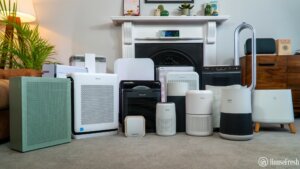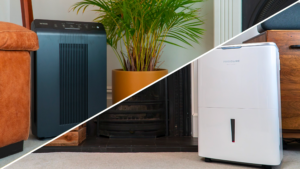Having low humidity in the home can make you feel uncomfortable. Your skin may dry out; your nose membranes can feel dry, and with dry mucous membranes, you may become susceptible to snoring.
Humidifiers help raise the home’s humidity levels, alleviating some of the problems caused by dry air. Portable humidifiers are available as warm mist, cool mist, or ultrasonic.
Here’s how each one works:
| TYPE OF HUMIDIFIER | HOW IT WORKS |
|---|---|
| Warm mist humidifiers | Heats water to turn it into steam and produce vapor. |
| Cool mist humidifiers | Uses a wick filter and a fan to turn water into vapor, which is then propelled into the room. |
| Ultrasonic humidifiers | Uses high-frequency vibrations to expel microscopic droplets of water into the air, where they evaporate. |
In this article, we’ll be concentrating on ultrasonic models; but before we get into more detail about them, you should quickly distinguish humidifiers from purifiers. They are very different appliances, as explained in detail here.
Ok let’s jump in and find out how ultrasonic humidifiers do their job of adding humidity to a room.
How ultrasonic humidifiers work
An ultrasonic humidifier uses a diaphragm that is subjected to high-frequency vibrations. The vibrations expel water droplets into the air as a fine mist, where they evaporate, increasing the room’s humidity.
The high-frequency vibrations are at a dB level higher than the audible range of humans, making them extremely quiet. Ultrasonic humidifiers do not use a fan, so they are silent. They also do not have any filters incorporated within them, so the water droplets produced will contain contaminants or impurities in the water, including any minerals from hard water.
Is there a downside?
Well, the minerals in your household water supply will be transported in droplets and into the air. As the water droplets evaporate, the minerals will be left behind, leaving a cloud of fine white dust that will drop onto surfaces near the humidifier.
To avoid this annoying dust byproduct, the EPA recommends using distilled water instead of tap water in ultrasonic humidifiers. Although purified water may still have some mineral content, it will be much less than tap water.
Six benefits of ultrasonic humidifiers
1. They are extremely quiet
Ultrasonic humidifiers are among the quietest humidifiers available. The unit may generate a noticeable humming, but they are virtually silent compared to a normal humidifier.
2. They do an excellent job humidifying indoor air
Ultrasonic humidifiers are so good that they can produce too much humidity if not watched.
To overcome this slight problem, it is recommended that ultrasonic humidifiers have humidistats to detect the humidity level and automatically switch the humidifier off when the moisture in the air reaches an acceptable level.
3. They are small
Thanks to the technology used, ultrasonic humidifiers can be made incredibly small, limited only by the size of the water tank. This makes them ideal if you have limited space to use them.
4. There is no heat involved
This means that they are safer than an evaporative humidifier that creates steam by boiling water to produce the vapor. This is crucial if you use the device in a child’s bedroom.
5. The operational costs of ultrasonic humidifiers are extremely low
They use far less electricity than a unit that boils water constantly to produce water vapor. As a result, they are inexpensive to run and are more environmentally friendly.
6. There are no ongoing running costs
Ultrasonic humidifiers don’t require parts, such as filters or wicks, to be replaced every so often, making them very cost-effective.
Four disadvantages of ultrasonic humidifiers
1. Some water may drop onto surfaces close to the humidifier
This becomes a significant problem if the room is colder than usual or is already humid. If the humidifier continues to run, the result could be damp areas or possibly puddles of water forming on adjacent surfaces.
2. Normal water can leave traces of minerals behind in the form of white dust
If distilled water isn’t used, as the droplets evaporate, any minerals suspended in the water will be transported into the air with the water droplets. When evaporation takes place, the minerals are left behind, falling onto surfaces as fine white dust. If the dust produced is high enough, there is a chance that it can be breathed in by anyone in the room.
3. The vibrations produced by ultrasonic humidifiers can bother your dog
The vibrations produced by an ultrasonic humidifier are above the audible range of humans, but they may be heard by your pets, particularly dogs. Their hearing is much more sensitive than yours, so if you plan to use an ultrasonic humidifier, keep an eye on your dog’s behavior, and if they appear distressed, the sound produced may be painful for them. If this happens, keep them out of the room where the humidifier is situated.
4. There is no filtration system in an ultrasonic humidifier
That means that any bacteria or contaminants in the water used will be expelled into the air. The result can be allergy symptoms or airborne diseases spreading throughout the home, known as “humidifier fever.”
Final thoughts
Every type of humidifier is designed to increase humidity levels in your home, but how they achieve this will be a deciding factor in your choice of model. From a safety point of view, if you use a humidifier that boils water to produce vapor in a child’s room, it may not be the ideal choice.
Cool mist humidifiers are somewhat safer, but they do make noise when running. Ultrasonic models are silent but may produce too much humidity if not checked. Understanding each technology type will ensure you make the right choice for your home.
SOURCES
- United States Environmental Protection Agency. (1991). Indoor Air Facts No. 8 Use and Care of Home Humidifiers. epa.gov







